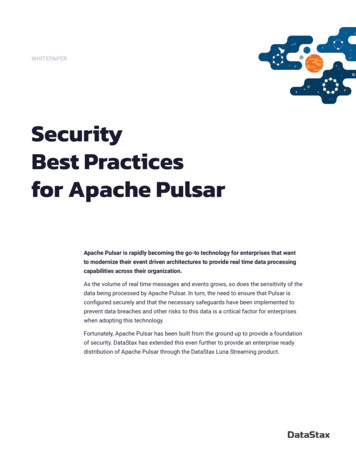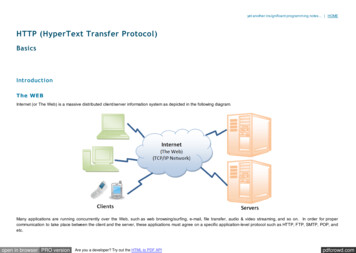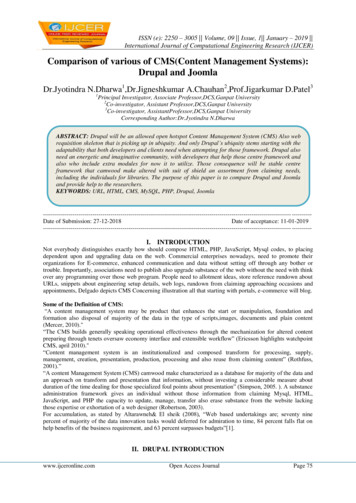
Transcription
WHITEPAPERSecurityBest Practicesfor Apache PulsarApache Pulsar is rapidly becoming the go-to technology for enterprises that wantto modernize their event driven architectures to provide real time data processingcapabilities across their organization.As the volume of real time messages and events grows, so does the sensitivity of thedata being processed by Apache Pulsar. In turn, the need to ensure that Pulsar isconfigured securely and that the necessary safeguards have been implemented toprevent data breaches and other risks to this data is a critical factor for enterpriseswhen adopting this technology.Fortunately, Apache Pulsar has been built from the ground up to provide a foundationof security. DataStax has extended this even further to provide an enterprise readydistribution of Apache Pulsar through the DataStax Luna Streaming product.
01A Layered Approachto SecurityIn this white paper we will walk through common aspects ofsecurity that you should take into account when implementingApache Pulsar along with guidance for how to configure yourPulsar instance to ensure secure operations:Infrastructure: With an emphasis on Kubernetes (k8s) based deployment, whatconsiderations and techniques should you employ to secure your Apache Pulsardeployment?Network Security: What can you do to ensure all communication within Pulsaroccurs over secure channels?Data Security: How should you secure message data and what steps would youneed to take to protect messages based on the sensitivity and classification of thedata they contain?Identity & Access Management: How can you configure Apache Pulsar to work withyour organization’s single sign on (SSO), identity provider, access control manager toprovide authentication and authorization?This whitepaper will also provide you with a guide to securely configure and operateDataStax Luna Streaming using many of the standard features found in Apache Pulsar aswell as capabilities such as SSO integration and enterprise authentication/authorizationwhich are exclusive to DataStax Luna Streaming.2Pulsar Security Whitepaper
02Infrastructure Securityon KubernetesKubernetes provides general guidance aroundbest practices for securing a k8s cluster.Comprehensive Kubernetes security is outside the scope of this document, however thereare a number of Pulsar-specific configurations that you should be aware of when runningyour cluster on Kubernetes. Luckily, the DataStax Helm Chart installer for Luna Streaminggives you a seamless way to quickly stand up your Apache Pulsar cluster using aconfiguration that automatically applies these configurations.Container Privilege LevelsLike any enterprise software, you should strive to implement a policy of least privilegesto ensure that the user the software is running as has the necessary permissions tocarry out its tasks, but no more.When using DataStax Luna Streaming, the default configuration will ensure that yourPulsar containers run as the pulsar user rather than root. This user is configured withgroup permissions to access the necessary locations on the container’s filesystem and toinvoke the necessary commands, but does not have superuser access on the container.Audit LoggingApache Pulsar using log4J as its logging framework. By default, Pulsar will log failedauthentication events from the following classes/log Filter / WARNorg.apache.pulsar.broker.service.ServerCnx / INFOLikewise, authorization failures are captured by the following class / log level:org.apache.pulsar.broker.service.ServerCnx / WARNAs part of your ongoing monitoring of Pulsar, you can use a third party product to monitorthe content of these logs to surface potential security issues such as brute force attackswhich you can then appropriately respond to.3Pulsar Security Whitepaper
03Network SecuritySecuring Connections Between Pulsar ComponentsIf the distribution of Apache Pulsar you are using is DataStax Luna Streaming, then youwill find that configuring TLS between components is a matter of simple configurationin the values.yaml file you supply as part of your Helm chart installation.4Pulsar Security Whitepaper
In this file you will find a TLS section which allows you to enable TLS selectively.The relevant section is shown here:enableTls: falsetlsSecretName: pulsar-tlstls:zookeeper:enabled: false# Enable TLS between broker and BookKeeperbookkeeper:enabled: false# Enable TLS between function worker and brokerfunction:enabled: false# Enable TLS between WebSocket proxy and brokerwebsocket:enabled: falseHelm chart values to configure TLS between Apache Pulsar components.Securing Apache Pulsar Admin API AccessPulsar provides a REST API endpoint which is used by the pulsar-admin command lineinterface as well as the Java administrative API. By default, the HTTP endpoint exposedby Pulsar is unencrypted. Rectifying this is simply a matter of configuring the appropriateTLS certificates and configuring them within Pulsar.To accomplish this, you will need to configure the webServicePortTls property in thebroker.conf file to enable TLS.One you have configured TLS, you will also need to enable authentication on this endpointby setting the following properties in broker.conf:authenticationEnabled trueauthorizationEnabled trueauthenticationProviders desired provider An example of configuring secure access on the broker can be found in the Pulsardocumentation.5Pulsar Security Whitepaper
Configuring a Secure Channel for ClientsPulsar clients communicate with the Pulsar brokers using the Pulsar binary protocolwhich is based on Protobuf. Clients establish a connection either directly to the broker(s)or to the Pulsar proxy which then routes the client’s request to the appropriate broker tohandle the request.By default, Pulsar configures brokers to communicate over unencrypted connections.To change this, you must configure the broker.conf to enable TLS. This is done byconfiguring the brokerServicePortTls property to have a value of true. Additionally, youcan configure the appropriate settings in that same file to instruct Pulsar to use the TLScertificates which have been issued by your organization’s certificate authority.Likewise, when using the Pulsar proxy component to serve as router to brokers, a similarconfiguration can be made in the proxy.conf file to ensure that clients that connect toPulsar do so over a secure channel.6Pulsar Security Whitepaper
04Ensuring Data Securityand ConfidentialityEncrypting Message DataCurrently BookKeeper does not provide support for encrypted ledger data. This meansthat there are two options for encrypting message data at rest. The first is to rely onencryption mechanisms at the physical storage layer such as disk level encryption. Thesesolutions will vary from provider to provider, however many common solutions encryptdisks only when they are unmounted, providing limited protection against an attackerwho has access to the VM/container where the disks are mounted.Luckily, Pulsar supports end-to-end encryption of message data. Using this approach, themessage producer encrypts messages before publishing them to Pulsar. The encryptedciphertext is stored as a byte array in BookKeeper and decrypted by message consumers.7Pulsar Security Whitepaper
This approach offers an airtight approach to encrypt message data with the tradeoff ofcomplexity for managing consumers and for accessing and replaying historical streamdata; by default Puslar will rotate the encryption keys every 4 hours.Message Retention and PurgingOne standard way to prevent data leaks is to simply delete data that is no longer required.Pulsar provides several mechanisms to assist with this. The first is that for a given topic,you have the option of configuring it as either persistent or non-persistent (ephemeral).Topics of either type can be easily identified by inspecting the fully qualified topic name.Persistent and non-persistent topics will begin with persistent:// andnon-persistent:// respectively.Non-persistent topics will never have their data persisted to BookKeeper. This can beconvenient for use cases which need to be optimized for performance or for cases wheremessage data loses its value if not immediately processed. This same capability can alsobe beneficial for cases where you want to avoid persisting sensitive data all togethersuch as in the context of payment use cases or where patient medical data is involved.For cases where message persistence is desired, but where you want to purge data aftera certain period of time, you can configure message retention policies at the namespacelevel within Pulsar. This is convenient if you have data which is subject to regulatorycompliance such as GDPR where the commonly recommended practice is to retainapplicable personal data for only as long as necessary before purging it from yoursystem. Using this capability in Pulsar you can set a retention period that is appropriatefor your organization, say 60 or 90 days, after which message data will be automaticallypurged from the system.Data Masking Using Pulsar FunctionsApache Pulsar includes a capability known as Pulsar Functions for in-stream processingof message data. This feature provides a simple mechanism which can be used topreserve the benefits of historical stream data while adhering to best practices arounddata privacy and retention. For example, from a data science perspective, it may bebeneficial to retain a historical record of order and payment messages from anecommerce system. However, these messages may contain PII or payment card datawhich introduce risks if stored indefinitely.8Pulsar Security Whitepaper
Pulsar functions allows you to programmatically modify message data and pass italong to a new topic:Using this technique you can implement data masking, data scrubbing and otherapproaches to adhere to your organization’s data handling procedures, while enablingdeeper analysis of event stream data from a historical context.Message Validation Using SchemasEnsuring message data is valid provides benefits from a data cleansing perspective, butalso offers security benefits as well. While we typically think of things like SQL injectionattacks as a concern for web applications, a similar attack surface exists anywhere thatdata is taken as an input and turned into a database command to modify the state of adata store. Likewise, an attacker could try to create an overflow condition by sending invery, very large amounts of data in a message to overwhelm your consumers and triggerdownstream problems throughout your organization.Pulsar provides support for Avro and native Protobuf based schemas. Using these allowsyou to ensure type safety of message payloads along with finer grained control overindividual data elements. For example, using Avro it is possible to validate JSON payloaddata using regular expressions, value ranges and other common approaches to ensuredata adheres to the format and acceptable limitations you set.9Pulsar Security Whitepaper
05Identify and AccessManagementAuthentication in PulsarPulsar uses a pluggable authentication model that includes support for the followingauthentication mechanisms: TLS Authentication – use client certificates to authenticate clients. Athenz – leverage Athenz tokens for client authentication Kerberos – SASL based approach for authentication using Kerberos JSON Web Token Authentication – JWT signature based authentication tied tosubject (sub) claim OAuth2 – use the OAuth2 client credentials flow to obtain tokens for authentication.Each of these approaches is backed by an AuthenticationProvider implementation which isresponsible for matching the subject in Pulsar to the role which that user has been granted.DataStax Luna Streaming extends these options with more full featured enterpriseauthentication capabilities. Luna Streaming ships with Keycloak, a full featured, opensource identity and access management solution. Keycloak allows you to integrate awide range of common authentication solutions into Pulsar including LDAP, SAML,OpenID Connect and others. Keycloak also supports user federation using Kerberos andLDAP. This ensures that developers can use standard technologies already in use withinyour organization to address common security requirements.Authorization in PulsarPulsar manages permissions at a namespace level and uses the concept of a role tospecify what actions the role is allowed to perform within the namespace. The allowedactions are either produce or consume.Additionally, Pulsar has a predefined set of permissions called superuser at the clusterlevel and a predefined set of permissions called admin at the tenant level.Superusers, as the name suggests, are allowed to perform any action within the clusterincluding administering tenants, namespaces and other resources as well as producingto/consuming from any topics anywhere in the cluster.10Pulsar Security Whitepaper
To specify the roles which should be given superuser permissions, you must supply themas part of your broker.conf file. If you are using the DataStax Luna Streaming helmchart, you can also specify this in the values.yaml file:superUserRoles s are limited to the tenant and have the ability to administer namespaces and otherresources within the tenant as well as producing to/consuming from any topics anywherein the tenant. To grant a role admin permissions on a tenant, you can specify this attenant creation time:bin/pulsar-admin tenants create my-tenant \--admin-roles my-admin-role \--allowed-clusters us-west,us-eastIf you want to change the roles which have been granted admin permissions on a giventenant you can do that as well using this command:bin/pulsar-admin tenants update my-tenant \--admin-roles original-admin-role, new-admin-roleFor finer grained access at a namespace level, the following command will allow you tospecify which roles are allowed to consume from/produce to topics in the namespace:bin/pulsar-admin namespaces grant-permission my-namespace \--actions consume \--roles consumer-roleThe allowed actions are either produce or consume. These can also be set when creatinga namespace.Monitoring Authentication MetricsPulsar exposes metrics that give you visibility into authentication events. These metricsare exposed in the standard Prometheus format, making it straightforward to connectPulsar with existing monitoring solutions in use within your organization. In addition tothe audit logging suggestions outlined above, monitoring these metrics can give youvisibility to incidents where authentication failures may spike and where furtherinvestigation is likely warranted.11Pulsar Security Whitepaper
06Lunar StreamingSecurity DifferentiatorsSecurity is a key part of implementing and adopting any technology.While Apache Pulsar provides a strong foundation for security, thesecapabilities alone may not be sufficient to meet the needs ofenterprise security standards in place at most large organizations.While we’ve covered many aspects of securing your Pulsar instances in this paper, there areother out of the box capabilities which are exclusive to DataStax Luna Streaming as well:Vulnerability Scanning – Every release of DataStax Luna Streaming undergoesvulnerability scans to ensure there are no known severe vulnerabilities in the release.Rapid Patches – When security vulnerabilities are detected DataStax is able to releasepatches outside the normal OSS release process which can result in faster time toremediation for security issues.Enterprise Authentication / Authorization – DataStax Luna Streaming ships withsupport for enterprise SSO and access control standards such as LDAP, SAML,OpenID Connect and others.Contact / Feedback / QuestionsIf you have feedback or questions about the content of this whitepaper or Pulsar ingeneral, we’d love to hear from you! You can reach the DataStax team who is focusedon Apache Pulsar by emailing pulsar-team@datastax.com. 2021 DataStax, All Rights Reserved. DataStax, Titan, and TitanDB are registered trademarks ofDataStax, Inc. and its subsidiaries in the United States and/or other countries.Apache, Apache Cassandra, and Cassandra are either registered trademarks or trademarks of theApache Software Foundation or its subsidiaries in Canada, the United States, and/or other countries.12Pulsar Security Whitepaper
Data Masking Using Pulsar Functions Apache Pulsar includes a capability known as Pulsar Functions for in-stream processing of message data. This feature provides a simple mechanism which can be used to preserve the benefits of historical stream data while adhering to best practices around data privacy and retention.











